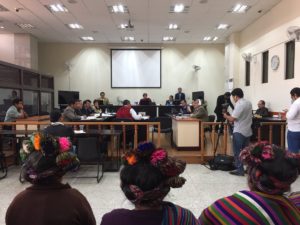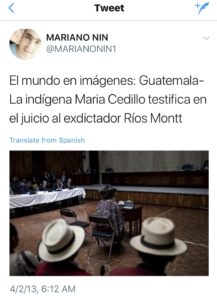Petrona Raymundo Brito was eight years old in October 1982, when the army arrived in her village in the Ixil region of Quiché in northwestern Guatemala. “When they arrived they burned our belongings, they burned our crops, and they killed our animals,” she told the court that is hearing genocide charges against former military intelligence chief Mauricio Rodríguez Sánchez. She also testified in closed-door proceedings against former dictator Efraín Ríos Montt, who is being prosecuted separately from Rodríguez Sánchez.
“They killed many people. My uncle and my aunt died there. They also killed my brother-in-law Jacinto Chen,” stated Raymundo Brito. Because of the army massacres, she said, “we fled to the mountains. Helicopters filled with soldiers passed overhead. They shot at us and threw bombs.” She paused. Because of the army’s persecution, she said, they were unable to build shelter from the rain and the cold. The witness testified that many people, including infants and children, perished from cold and hunger.
Andrés Lainez Chávez was 16 years old when the army came to his village in the Ixil region. He described army massacres in which soldiers killed people with guns and machetes. Those who were able to escape fled to the mountains. “They bombed us every day. We ate herbs to survive. We could not make a fire. My mother and my nephews died in the mountains. Many people died of hunger and disease. Others died as a result of the army bombings.”
He added: “I ask the court to do justice so that this does not happen again, so that the children and those who are yet to be born do not experience what we have had to endure… It is very sad. Many people died, some were left lying on the ground and the dogs ate them, they killed people with guns and with machetes. It was very painful.”
Tomás Chávez Brito told the trial court that he was two years old when the army came to his village and began massacring his neighbors. “After the army arrived, we had to flee to the mountains. They set the houses on fire. In one of the houses there was a baby inside. The soldiers killed my sister.” He continued: “They cut down our cornfield. In the mountains we did not have food. But we did not go to the town out of fear.”
Chávez Brito testified that he was eventually captured by the army and taken to the La Perla military base, where he observed airplanes and an airstrip. At the army base, he was reunited with several of his family members who had been captured previously. Some of his family members were later taken away from the military base, he stated. He never saw them again.
María Cedillo, an Ixil woman from Santa María Nebaj, a municipality in the department of El Quiché that is one of the three main communities in the Ixil region, along with San Juan Cotzal and San Gaspar Chajul, also testified in the genocide proceedings. She told the court that the soldiers cut down the cornfields because they wanted to kill everyone from the community. “They wanted to disappear Nebaj in its entirety,” she said.
“We don’t want more violence,” Cedillo added. “We want justice so this never happens again.”
These five witnesses represent some of the survivor testimonies that have been heard in the public trial against Rodríguez Sánchez, who, like Ríos Montt, is accused of genocide and crimes against humanity. The case against Ríos Montt is taking place in parallel, closed-door proceedings.
Genocide Retrial Recap
Each of the witnesses testified previously in the 2013 genocide trial in which Ríos Montt was found guilty, while Rodríguez Sánchez was acquitted. Under pressure by powerful economic and military elites, the Constitutional Court issued a controversial ruling that partially suspended the proceedings, thereby vacating the verdict.
After several failed attempts to launch the retrial, the case reopened on October 13. However, the court separated the cases against the two defendants following a Constitutional Court ruling that determined that the 2016 proceedings violated the due process rights of Rodríguez Sánchez and the victims in the case to a public trial.
High Risk Court “B” is hearing both cases. The tribunal consists of three ad hoc judges who are able to meet only once a week, on Fridays. This is because the judges in each of the three high risk courts have previously participated in one of the proceedings in this case.
The Ríos Montt trial has been taking place on Friday mornings and is closed to the public. The Rodríguez Sánchez trial takes place in the afternoon in open, public sessions. Trial monitors are not allowed into the Ríos Montt trial, therefore International Justice (IJ) Monitor cannot directly report on those proceedings, but we are able to observe the Rodríguez Sánchez trial.
Two of the defense attorneys for Ríos Montt, Jaime Hernández and Luis Rosales, who were removed from the courtroom after they insisted on recusing the trial court judges, were allowed to return to the courtroom after winning a provisional protective measure. Hernández and Rosales filed a new request for the judges to recuse themselves, which the judges again rejected, saying that the matter had already been resolved.

Ixil women accompany the survivor-witnesses testifying before the court in the Maya Ixil genocide trial. The accused, Mauricio Rodríguez Sánchez, is seated to the right wearing headphones.
Seven hearings have taken place since the parallel proceedings opened on October 13. In each trial, to date, a dozen witnesses have provided their testimony. In the initial sessions, the court required the witnesses called in the morning sessions to repeat their testimony in the afternoon proceedings. However, because of a concern that this practice was retraumatizing victims, human rights lawyers told IJ Monitor they asked the court to require witnesses to testify only once in a given day. Since December 1, therefore, different witnesses have been testifying in the morning and afternoon hearings. About 100 witnesses are expected to testify before the court, in addition to several expert witnesses.
Official Documents Presented as Evidence of the Army’s Scorched Earth Policy
During the hearings, the plaintiffs presented and read aloud portions of a number of official documents and military manuals describing the counterinsurgency operations, including fragments of documents entitled “Civil Affairs Assessment,” “Operation Ixil,” and the “Counterinsurgency War Manual.” According to the Attorney General’s office, these documents were prepared by the Command School and the General Staff of the Guatemalan Army and were employed as guidelines in the implementation of the counterinsurgency war.
Government prosecutor Erick de León read aloud segments of one document that highlighted the importance of psychological operations in the region, as well as the inclusion of techniques to combat guerrilla warfare based on the experiences of Argentina, the United States, Peru, and France. The documents also describe techniques for extracting information and the names of contacts from detained individuals, as well as for discovering guerrilla hideouts. Such details reveal the role of military intelligence in military operations and especially its centrality in the execution of missions in compliance with military plans.
Some of these documents describe the emergence of the Guerrilla Army of the Poor (EGP) in 1977. The documents assert that the EGP was founded by members of the Association of University Students (AEU) of San Carlos University, who were allegedly trained in the former Soviet Union and in Havana, Cuba. The documents also highlight the strategic importance of the Ixil Triangle for the army. One document includes a step-by-step plan to increase food production in the area, which was very low due to the alleged presence of 1,200 guerrilla fighters.
The next hearings will take place on December 15 and 22, after which the court will hold hearings daily, except on holidays, until January 5, 2018, in an effort to accelerate the proceedings.
Jo-Marie Burt is an Associate Professor of Political Science and Latin American Studies at George Mason University. She is also a Senior Fellow at the Washington Office on Latin America (WOLA). Paulo Estrada is a human rights activist, archaeology student at San Carlos University, and civil party in the Military Diary case.

